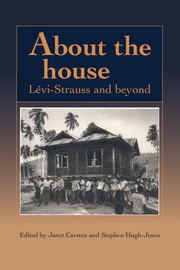Book contents
- Frontmatter
- Contents
- List of illustrations
- List of contributors
- 1 Introduction
- 2 Houses and hierarchies in island Southeast Asia
- 3 The resurrection of the house amongst the Zafimaniry of Madagascar
- 4 The hearth-group, the conjugal couple and the symbolism of the rice meal among the Kelabit of Sarawak
- 5 Houses in Langkawi: stable structures or mobile homes?
- 6 Having your house and eating it: houses and siblings in Ara, South Sulawesi
- 7 The Lio House: building, category, idea, value
- 8 Houses and hierarchy: the view from a South Moluccan society
- 9 Houses, places and people: community and continuity in Guiana
- 10 The houses of the Mẽbengokre (Kayapó) of Central Brazil – a new door to their social organization
- 11 Inside-out and back-to-front: the androgynous house in Northwest Amazonia
- Notes
- Bibliography
- Index
8 - Houses and hierarchy: the view from a South Moluccan society
Published online by Cambridge University Press: 05 June 2012
- Frontmatter
- Contents
- List of illustrations
- List of contributors
- 1 Introduction
- 2 Houses and hierarchies in island Southeast Asia
- 3 The resurrection of the house amongst the Zafimaniry of Madagascar
- 4 The hearth-group, the conjugal couple and the symbolism of the rice meal among the Kelabit of Sarawak
- 5 Houses in Langkawi: stable structures or mobile homes?
- 6 Having your house and eating it: houses and siblings in Ara, South Sulawesi
- 7 The Lio House: building, category, idea, value
- 8 Houses and hierarchy: the view from a South Moluccan society
- 9 Houses, places and people: community and continuity in Guiana
- 10 The houses of the Mẽbengokre (Kayapó) of Central Brazil – a new door to their social organization
- 11 Inside-out and back-to-front: the androgynous house in Northwest Amazonia
- Notes
- Bibliography
- Index
Summary
PARADOXES OF SINGULARITY AND MULTIPLICITY
Evans-Pritchard may have been the first to formulate the problem as a paradox – for the Nuer, the paradox of a patrilineal principle so unchallenged as to allow for the realization of practically everything except patrilineality (1951: 28; cf. Sahlins 1965). Yet, in part because of the force of his own rhetoric, he has hardly been the last. Moyer, for instance, has recently rephrased the Nuer paradox to fit an Indonesian context. Speaking of south Sumatra, he has asserted that the ‘paradox of unilineality’ implies that ‘the more unilineal a system is or becomes the less likely it is to remain unilineal’ (1983: 257). The situation, however, is not unique to the Nuer or to south Sumatra. Across the ethnographic spectrum – from Africa to Indonesia – the multiplicity of the forms of affiliation and residence found within societies has confounded ethnographers and defied the simple exclusivity of their analytic categories.
In Indonesia, the problem has been further compounded by the multiplicity of the forms of marriage that are found both within and between societies. Describing the aim of his book Types of Social Structure in Eastern Indonesia (1968 (1935)), van Wouden noted, some years later, that he had
… attempted to deal with the erratic distribution and intermingling of patrilineal and matrilineal forms of social organization and of unilateral circulating marriage systems with mother's brother's daughter marriage, father's sister's daughter's marriage and symmetric alliance with brother–sister exchange.
- Type
- Chapter
- Information
- About the HouseLévi-Strauss and Beyond, pp. 170 - 188Publisher: Cambridge University PressPrint publication year: 1995
- 12
- Cited by



